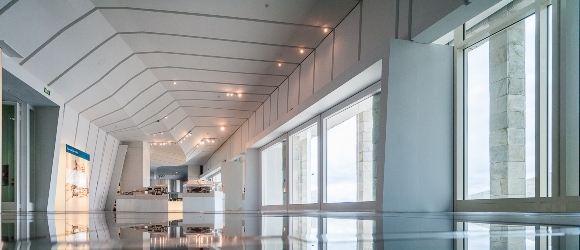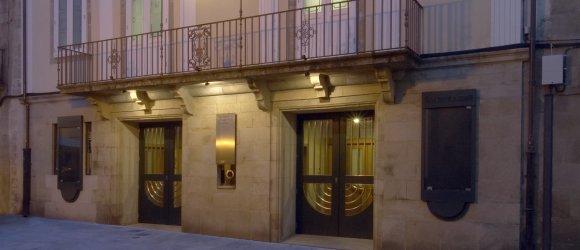 MUSEO CENTRO GAIÁS
Cidade da Cultura de Galicia. Monte Gaiás s/n
MUSEO CENTRO GAIÁS
Cidade da Cultura de Galicia. Monte Gaiás s/n
Principal escenario de Escenas do cambio desde a súa primeira edición. A súa beleza e flexibilidade converten a este edificio da Cidade da Cultura de Galicia no espazo perfecto para acoller exposicións de gran dimensión, eventos culturais e espectáculos de artes escénicas.
Andar -1: Sala 1
Andar 0: Hall de tirantes
 GALERÍA DE SERVIZOS DO GAIÁS
Cidade da Cultura de Galicia. Monte Gaiás s/n
GALERÍA DE SERVIZOS DO GAIÁS
Cidade da Cultura de Galicia. Monte Gaiás s/n
Galería de túneles que percorre os sotos do complexo e conecta entre si os diferentes edificios da Cidade da Cultura. Empregado de maneira principal para facilitar o acceso de materiais a cada espazo e tamén como escenario de espectáculos escénicos e musicais.
 SALA EISENMAN
Cidade da Cultura de Galicia. Monte Gaiás s/n
SALA EISENMAN
Cidade da Cultura de Galicia. Monte Gaiás s/n
Sala polivalente situada no Centro de Emprendemento Creativo da Cidade da Cultura. Concibida como un espazo diáfano no que a luz e as vistas á praza central do Gaiás son protagonistas, a súa versatilidade permite acoller todo tipo de eventos, presentacións e espectáculos.
 EDIFICIO CINC
Cidade da Cultura de Galicia. Monte Gaiás s/n
EDIFICIO CINC
Cidade da Cultura de Galicia. Monte Gaiás s/n
Sede da Fundación Cidade da Cultura e da Axencia para a Modernización Tecnolóxica de Galicia, que aglutina os servizos tecnolóxicos da Administración galega. Ten varios auditorios para a celebración de eventos ou espectáculos, entre os que se atopa o Salón de Convencións.
 BOSQUE DE GALICIA
Cidade da Cultura de Galicia. Monte Gaiás s/n
BOSQUE DE GALICIA
Cidade da Cultura de Galicia. Monte Gaiás s/n
O Bosque de Galicia, o gran pulmón verde que se ergue nas ladeiras do monte Gaiás, acolle, ademais de preto de doce mil árbores de especies autóctonas, diversas intervencións artísticas. Enre elas, atopamos o conxunto escultórico «Espellos», realizado por Manolo Paz para afianzar o vínculo da Cidade da Cultura co Camiño e con Santiago de Compostela.
 XARDÍN DO TEATRO
Cidade da Cultura de Galicia. Monte Gaiás s/n
XARDÍN DO TEATRO
Cidade da Cultura de Galicia. Monte Gaiás s/n
O Xardín do Teatro é un espazo verde no corazón do complexo arquitectónico da Cidade da Cultura que conta con especies botánicas procedentes de diferentes partes do mundo, un auditorio ao aire libre, estanques e áreas de lecer para gozar do deporte e da natureza.
 SALÓN TEATRO
Rúa Nova, 34 - Santiago de Compostela
SALÓN TEATRO
Rúa Nova, 34 - Santiago de Compostela
Situado na zona histórica de Santiago de Compostela e xestionado na actualidade pola Consellería de Cultura, Educación, FP e Universidades, a través de Agadic, o Salón Teatro acolle a exhibición en Compostela de todas as producións do Centro Dramático Galego — que ten aquí a súa sede —, ademais dunha programación aberta ás distintas disciplinas escénicas, á música e ao cinema. A súa capacidade é de 272 butacas.
 SANTIAGO DE COMPOSTELA
SANTIAGO DE COMPOSTELA
Capital de Galicia, Santiago de Compostela é unha cidade declarada Patrimonio da Humanidade pola UNESCO grazas á súa beleza monumental, extraordinaria conservación e por ser meta dunha milenaria ruta de peregrinación: o Camiño de Santiago. A arte do Románico, o Barroco e o Renacemento deron forma á imaxe monumental da urbe, onde conflúen mosteiros, igrexas, casas señoriais e prazas nas que o tempo escolleu quedar detido.








